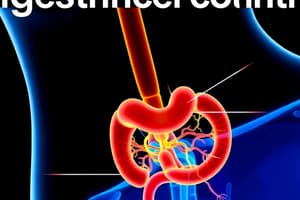Podcast
Questions and Answers
What is the primary function of the stomach in relation to ingested food?
What is the primary function of the stomach in relation to ingested food?
- Breaking down food through enzymatic action
- Short-term storage of ingested food (correct)
- Absorption of nutrients
- Production of digestive enzymes
Which nerve pathways are involved in the process of receptive relaxation of the stomach?
Which nerve pathways are involved in the process of receptive relaxation of the stomach?
- Sympathetic nervous system pathways
- Vagus nerve pathways (correct)
- Peripheral nervous system pathways
- Spinal cord pathways
What role does nitric oxide (NO) play in gastric motor function?
What role does nitric oxide (NO) play in gastric motor function?
- Stimulates gastric acid secretion
- Facilitates muscle contraction
- Inhibits food mixing
- Promotes relaxation of stomach muscles (correct)
Which statement correctly describes gastric accommodation?
Which statement correctly describes gastric accommodation?
What is the function of the pyloric sphincter in gastric motor activity?
What is the function of the pyloric sphincter in gastric motor activity?
What is the primary function of the vagal afferents in the gastrointestinal tract?
What is the primary function of the vagal afferents in the gastrointestinal tract?
Which part of the gastrointestinal tract has the fastest smooth muscle slow waves?
Which part of the gastrointestinal tract has the fastest smooth muscle slow waves?
What type of reflexes result from the intrinsic control of the gastrointestinal tract?
What type of reflexes result from the intrinsic control of the gastrointestinal tract?
What role do Interstitial Cells of Cajal play in smooth muscle activity?
What role do Interstitial Cells of Cajal play in smooth muscle activity?
How often do smooth muscle slow waves occur in the stomach?
How often do smooth muscle slow waves occur in the stomach?
Which type of cells are responsible for gastric acid secretion?
Which type of cells are responsible for gastric acid secretion?
What type of innervation do postganglionic efferent fibers provide in the enteric system?
What type of innervation do postganglionic efferent fibers provide in the enteric system?
What kind of activity occurs due to cycles of depolarization in smooth muscle?
What kind of activity occurs due to cycles of depolarization in smooth muscle?
What role do motor neurons play in the enteric nervous system?
What role do motor neurons play in the enteric nervous system?
What is the primary function of the Meissner’s Plexus?
What is the primary function of the Meissner’s Plexus?
Which neurotransmitter is primarily used by the sympathetic nervous system to decrease motility and secretions?
Which neurotransmitter is primarily used by the sympathetic nervous system to decrease motility and secretions?
What describes the main function of the autonomic nervous system in relation to the GI tract?
What describes the main function of the autonomic nervous system in relation to the GI tract?
Which structure of the enteric nervous system is located between the longitudinal and circular smooth muscle layers?
Which structure of the enteric nervous system is located between the longitudinal and circular smooth muscle layers?
Which statement is true about the intrinsic control of the GI tract?
Which statement is true about the intrinsic control of the GI tract?
How does the parasympathetic nervous system affect gastrointestinal contractions?
How does the parasympathetic nervous system affect gastrointestinal contractions?
What type of neurons convey information regarding muscle stretch and chemical composition from the mucosa?
What type of neurons convey information regarding muscle stretch and chemical composition from the mucosa?
What initiates stomach contractions during the cephalic phase?
What initiates stomach contractions during the cephalic phase?
Which hormone is responsible for increasing the number and force of stomach contractions?
Which hormone is responsible for increasing the number and force of stomach contractions?
What role do mechanical stimuli play in gastric contractions?
What role do mechanical stimuli play in gastric contractions?
How does the composition of food entering the duodenum affect gastric motility?
How does the composition of food entering the duodenum affect gastric motility?
What characterizes the emptying process from the stomach to the duodenum?
What characterizes the emptying process from the stomach to the duodenum?
What happens to pressure in the stomach as volume increases?
What happens to pressure in the stomach as volume increases?
Where does the contraction process start in the stomach?
Where does the contraction process start in the stomach?
How does the force of contractions change as they approach the pyloric sphincter?
How does the force of contractions change as they approach the pyloric sphincter?
What is the result of contractions overtaking the stomach contents?
What is the result of contractions overtaking the stomach contents?
What occurs during the fasted state of the stomach?
What occurs during the fasted state of the stomach?
Which region of the stomach is referred to as the pacemaker region?
Which region of the stomach is referred to as the pacemaker region?
What is the role of the pyloric sphincter in the stomach?
What is the role of the pyloric sphincter in the stomach?
Which of the following best describes the contractions moving towards the pyloric region?
Which of the following best describes the contractions moving towards the pyloric region?
Flashcards are hidden until you start studying
Study Notes
Control of the GI Tract
- Control of the gastrointestinal (GI) tract is managed through neural and humoral factors.
- Intrinsic control is governed by the enteric nervous system (ENS), while extrinsic control involves the autonomic nervous system (ANS).
- GI hormones play a role in both intrinsic and extrinsic control.
Enteric Nervous System (ENS)
- The ENS consists entirely of neurons within the GI tract.
- Comprises three types of neurons: sensory neurons (detecting stretch and chemical content), motor neurons (controlling motility and secretions), and inter-neurons (relaying information between sensory and motor neurons).
- Arranged in two main plexuses:
- Myenteric (Auerbach's) Plexus: located between circular and longitudinal smooth muscle, regulates motor function.
- Submucosal (Meissner’s) Plexus: regulates mucosal secretion.
Extrinsic Control of the GI Tract
- Controlled by the autonomic nervous system.
- Parasympathetic Nervous System:
- Vagus nerve and pelvic nerve innervate plexuses, enhancing gastric contractions and secretions via acetylcholine (ACh).
- Acts as "rest and digest," providing sensory feedback.
- Sympathetic Nervous System:
- Originates from prevertebral ganglia, reducing motility and secretions primarily through noradrenaline.
Smooth Muscle Slow Waves
- Initiated by Interstitial Cells of Cajal located between smooth muscle layers.
- Waves of contraction depend on cycles of depolarization that may require additional stimulation from the ANS or hormones.
- Frequencies vary:
- Duodenum: every 4-5 seconds
- Ileum: every 6-7 seconds
- Stomach and colon: approximately every 20 seconds.
Gastric Motor Function
- The stomach has three main functions:
- Short-term storage of food.
- Mixing of gastric contents.
- Controlled emptying into the intestines.
Receptive Relaxation
- Swallowing triggers relaxation of the lower esophagus and proximal stomach via a vagovagal reflex.
- Allows the stomach to accommodate food volume without a significant rise in pressure, controlled by the enteric nervous system.
Mixing and Emptying
- The distal stomach exhibits a spontaneous electrical rhythm similar to the small intestine.
- Contractions begin mid-stomach and intensify as they reach the pyloric sphincter, facilitating the mixing of contents and gradual emptying.
Factors Affecting Contractions
- The stomach is relatively inactive in the fasted state but shows contractions during the cephalic phase (anticipation of food).
- In the fed state, contractions are continuous, influenced by:
- Mechanical stimuli (distension).
- Neurotransmitters like ACh, which enhance contractions.
- Hormones such as gastrin (increases contractions) and secretin (decreases contractions).
Emptying
- Coordinated contractions lead to effective emptying, influenced by the relaxatation of the pylorus and limited contractions in the duodenum.
- Gastric emptying time depends on food composition:
- Liquids empty quickly while solids take longer due to the need for size reduction.
- Food composition activates receptors in the duodenum, prompting hormonal release that adjusts gastric motility.
Studying That Suits You
Use AI to generate personalized quizzes and flashcards to suit your learning preferences.




